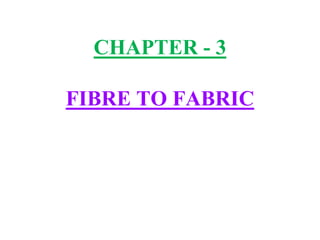
Class-7 science Chapter-3 fiber to fabric
- 1. CHAPTER - 3 FIBRE TO FABRIC
- 2. 1) Animal fibres :- The common animal fibres are wool and silk. Wool is obtained from sheep, goat, yak, camel, llama, alpaca etc. Silk is obtained from silk worm. Sheep
- 3. Goat
- 4. Yak
- 5. Camel
- 6. Llama
- 7. Alpaca
- 8. Silkworm
- 9. 2) Wool :- Wool is obtained from the fleece (hair ) of sheep, goat, camel, yak, llama, alpaca and other animals. These animals have a thick coat of hair on their bodies because the hair traps air and air is a poor conductor of heat. So the hair keeps their body warm. The most common wool is sheep wool. Yak wool is common in Tibet and Ladakh. The wool obtained from Angora goats of Jammu Kashmir is soft wool used for making shawls. Camel hair is also used as wool. Llama and Alpaca found in South America also yield wool.
- 10. 3) From fibres to wool :- For obtaining wool sheep are reared and then their hair is cut and processed into wool. a) Rearing and breeding of sheep :- Sheep are reared in many parts our country like Jammu and Kashmir, Himachal Pradesh, Uttaracnhal, Sikkim, Arunachal Pradesh, Haryana, Punjab, Rajasthan, Gujarat etc. Sheep feed on grass and leaves. They are also fed with a mixture of pulses, corn, jowar, oilcakes and minerals. In winter sheep are kept indoors and fed on leaves, grain and dry fodder. Some breeds of sheep have thick hair on their body which yield good quality wool in large quantities. They are selectively bred to get sheep of good breed.
- 11. b) Processing fibres into wool :- The processing of fibres into wool is done in six steps :- i) The fleece (hair) of the sheep is removed from its body along with a thin layer of skin by using machines. This process is called shearing. ii) The sheared skin with hair is washed in tanks to remove grease, dust and dirt. This process is called scouring. iii) The hairy skin is sent to a factory where hairs of different textures are separated. This process is called sorting. iv) The small fluffy fibres called burrs are separated from the hairs and again washed and dried. v) The fibres are then dyed in different colours. vi) The fibres are then straightened, combed and rolled into yarn. They are then spun and woven into fabric.
- 14. 4a) Silk :- Silk is obtained from silkworms. The rearing of silkworms for obtaining silk is called sericulture. b) Life history of silk moth :- The female silk moth lays eggs which hatch into larvae called caterpillars or silk worms. The larva feeds on mulberry leaves and grows in size. Then it secretes fibers made of protein and weaves the fibres around itself completely and forms pupa. This covering is called cocoon. The pupa then develops into a young silk moth. Silk yarn (thread) is obtained from the cocoon of the silk moth. The most common silk moth is the mulberry silk moth.
- 16. Adult silk moth Eggs Larva (Caterpiller) Pupa (Cocoon) Life history of silk moth
- 17. Adult silk moth Female silk moth with eggs Eggs Caterpiller (Larva)Cocoon (Pupa) Cocoon with developing moth Life history of silk moth
- 18. Mulberry tree
- 19. 5) From cocoon to silk :- Silk moths are reared and their cocoons are collected to get silk yarns (threads). a) Rearing of silkworms :- The female silk moth lays eggs. The eggs are warmed to a suitable temperature.The eggs hatch into larvae called caterpiller or silk worms. The silkworms are kept in bamboo trays and feeds on mulberry leaves and grows in size. After 30 to 40 days the silk worms stop eating and begins to spin cocoons. Inside the cocoon the silk worm develops into silk moth. b) Processing of silk :- The cocoons are collected and kept in sunlight or boiled or exposed to steam. The silk fibres separate out. The process of taking out the fibres from the cocoons is called reeling. Reeling is done by machines. The silk fibres are then spun into threads and woven into silk cloth.
- 20. From cocoon to silk